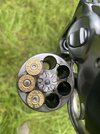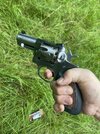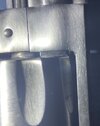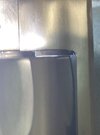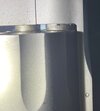Just bought a new Wiley Clapp 3" GP-100 with a 7 round cylinder. Love the feel and the sights, seems like a good gun.
Today I went and shot it with some cheap 38 SPL ammo (125gr TMJ) and some Remington .357 125gr SJHPs. The problem I'm running into is this:
Sometimes the trigger pull gets very heavy. Like, if it's a 9 lb trigger pull, it will crank up to 30lbs (not measured, just extremely high). I can't tell that anything is hanging up, but it happened on every cylinder of 38, and 2 out of 3 cylinders of 357 (though on fewer rounds in the cylinder - instead of 3-4 it might be 2, but it's still there). When this happens it takes more effort to release the cylinder, but I'm not seeing anything wrong with the brass, and I can't tell that the rounds are touching each other in the cylinder. This is the latter half of the trigger pull where I'm mostly experiencing this, though a couple of times I noticed, let the hammer back down, and the cylinder hadn't advanced so maybe it's not that late in the pull that it's happening.
Note that I shot this dry - I'd never fire a 1911 without making sure it was nice and lubed up first, but I'm new to revolvers and if they need more care than this then I'm unaware of what to do.
Note that these all fire fine through Taurus and S&W revolvers. Same ammo, new gun, only happens in the new gun.
Any ideas?
Today I went and shot it with some cheap 38 SPL ammo (125gr TMJ) and some Remington .357 125gr SJHPs. The problem I'm running into is this:
Sometimes the trigger pull gets very heavy. Like, if it's a 9 lb trigger pull, it will crank up to 30lbs (not measured, just extremely high). I can't tell that anything is hanging up, but it happened on every cylinder of 38, and 2 out of 3 cylinders of 357 (though on fewer rounds in the cylinder - instead of 3-4 it might be 2, but it's still there). When this happens it takes more effort to release the cylinder, but I'm not seeing anything wrong with the brass, and I can't tell that the rounds are touching each other in the cylinder. This is the latter half of the trigger pull where I'm mostly experiencing this, though a couple of times I noticed, let the hammer back down, and the cylinder hadn't advanced so maybe it's not that late in the pull that it's happening.
Note that I shot this dry - I'd never fire a 1911 without making sure it was nice and lubed up first, but I'm new to revolvers and if they need more care than this then I'm unaware of what to do.
Note that these all fire fine through Taurus and S&W revolvers. Same ammo, new gun, only happens in the new gun.
Any ideas?


